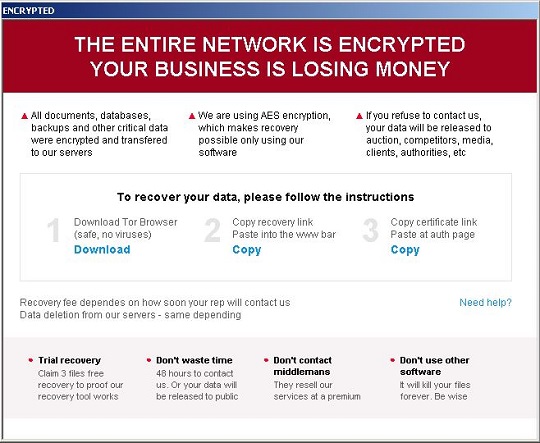Ransom.Win32.TRIGONA.YMDGU
Trojan-Ransom.Trigona (IKARUS)
Windows


Threat Type: Ransomware
Destructiveness: No
Encrypted:
In the wild: Yes
OVERVIEW
This Ransomware arrives on a system as a file dropped by other malware or as a file downloaded unknowingly by users when visiting malicious sites.
It drops files as ransom note.
TECHNICAL DETAILS
Arrival Details
This Ransomware may arrive via network shares.
It arrives on a system as a file dropped by other malware or as a file downloaded unknowingly by users when visiting malicious sites.
Installation
This Ransomware adds the following processes:
- %system%\cmd.exe /c\"bcdedit /set{default} recoveryenabled No\"
- %system%\cmd.exe /c\"bcdedit /set {default} bootstatuspolicy ignoreallfailures\"
- %system%\cmd.exe /c\"wbadmin DELETE BACKUP -keepVersions:0\"
- %system%\cmd.exe /c\"wbadmin DELETE SYSTEMSTATEBACKUP -keepVersions:0\"
- %system%\cmd.exe /c\"wmic SHADOWCOPY DELETE\"
- %system%\cmd.exe /c\"vssadmin delete shadows /all /quiet\"
- %system%\mshta.exe %User Temp%\how_to_decrypt.hta
(Note: %User Temp% is the current user's Temp folder, which is usually C:\Documents and Settings\{user name}\Local Settings\Temp on Windows 2000(32-bit), XP, and Server 2003(32-bit), or C:\Users\{user name}\AppData\Local\Temp on Windows Vista, 7, 8, 8.1, 2008(64-bit), 2012(64-bit) and 10(64-bit).)
It adds the following mutexes to ensure that only one of its copies runs at any one time:
- BC92B03B9486BB5F7A0672
Other System Modifications
This Ransomware adds the following registry entries:
HKEY_CURRENT_USER\Software\Microsoft\
Windows\CurrentVersion\Run
{Generated ID 1} = {malware file path}\{malware name}.exe
HKEY_CURRENT_USER\Software\Microsoft\
Windows\CurrentVersion\Run
{Generated ID 2} = %User Temp%\how_to_decrypt.hta
Information Theft
This Ransomware gathers the following data:
- Computer Name
- Username
- OS Version
- System Time
- Keyboard Locale
- Disk Data
Other Details
This Ransomware does the following:
- By default, It encrypt local drives and network drives
- It displays its ransom note after encryption
- It spreads through vulnerable MS-SQL servers via brute-force attack.
It accepts the following parameters:
- /r → encrypt files in random order
- /sleep → sleep for n seconds before execution
- /full → encrypt the whole contents of a file (by default, only the first 0x80000 bytes/512kb are encrypted)
- /debug → execute in debug mode, need to be executed with /p
- /log_f → for logging, specify the log file
- /fast →
- /erase → delete contents of a file
- /!autorun → Do not create autorun registry entry
- /is_testing → for testing purposes, used with /test_cid and /test_vid
- /test_cid → Use the specified value instead of generating a computer ID
- /test_vid → Use the specified value instead of the hardcoded victim ID (VID) from the configuration
- /p → specify path to encrypt
- /path → specify path to encrypt
- /!local → Do not encrypt local files
- /!lan → Do not encrypt network shares
- /shdwn → Turn off the machine after encryption using the parameter -f -s -t 00
- /allow_system → Allows encrypting files in system directory
- /!clear_shadow → Do not delete shadow copies
- /wipe →
- /autorun_only → Create Autorun registry entry(this does not trigger the encryption)
- /block →
- /step →
- /band_start →
- /!prerename → Do not rename files before encryption
Ransomware Routine
This Ransomware avoids encrypting files with the following strings in their file name:
- how_to_decrypt.hta
- how_to_decrypt.txt
It avoids encrypting files with the following strings in their file path:
- windows
- system32
It renames encrypted files using the following names:
- available_for_trial.{random}._locked
- {random}._locked
It drops the following file(s) as ransom note:
- %User Temp%\how_to_decrypt.hta
- {Encrypted Directory}\how_to_decrypt.hta

SOLUTION
Step 1
Trend Micro Predictive Machine Learning detects and blocks malware at the first sign of its existence, before it executes on your system. When enabled, your Trend Micro product detects this malware under the following machine learning name:
- TROJ.Win32.TRX.XXPE50FFF070
Step 2
Before doing any scans, Windows 7, Windows 8, Windows 8.1, and Windows 10 users must disable System Restore to allow full scanning of their computers.
Step 3
Note that not all files, folders, and registry keys and entries are installed on your computer during this malware's/spyware's/grayware's execution. This may be due to incomplete installation or other operating system conditions. If you do not find the same files/folders/registry information, please proceed to the next step.
Step 4
Delete this registry value
Important: Editing the Windows Registry incorrectly can lead to irreversible system malfunction. Please do this step only if you know how or you can ask assistance from your system administrator. Else, check this Microsoft article first before modifying your computer's registry.
- In HKEY_CURRENT_USER\Software\Microsoft\Windows\CurrentVersion\Run {Generated ID 1} = {malware file path}\{malware name}.exe
- In HKEY_CURRENT_USER\Software\Microsoft\Windows\CurrentVersion\Run {Generated ID 2} = %User Temp%\how_to_decrypt.hta
Step 5
Search and delete these files
- %User Temp%\how_to_decrypt.hta
- {Encrypted directory}\ how_to_decrypt.hta
Step 6
Scan your computer with your Trend Micro product to delete files detected as Ransom.Win32.TRIGONA.YMDGU. If the detected files have already been cleaned, deleted, or quarantined by your Trend Micro product, no further step is required. You may opt to simply delete the quarantined files. Please check the following Trend Micro Support pages for more information:
Did this description help? Tell us how we did.

